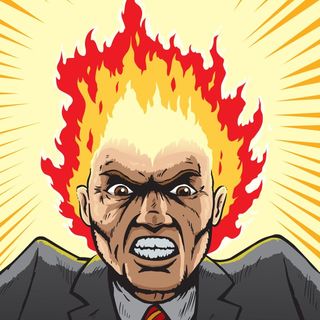Anger
Understanding Anger
Anger, hostility, and anxiety are all related and may or may not be destructive.
Posted June 17, 2017
Violence of all types is today quite frequent and greatly problematic, both domestically and internationally. It is especially important therefore to understand anger, hostility, and anxiety and their permutations because all are sometimes major ingredients in violence of all types. As clinicians, we devote a considerable portion of our thinking and practice to unearthing, clarifying, and tracing early the manifestations of anger in our patients. In depression we look for evidence of anger behind the saddened aspect; in histrionic disorders we experience angry seductiveness; in sexual disorders we see angry dependency; in marital problems we unearth distorted patterns of communication, particularly involving anger. We interpret the presence of anger, we confront anger, we draw anger, we tranquilize anger, and we help the working through of anger. Patients fear their angry feelings because they are sometimes connected with violence. However, other related feelings, hostility and anxiety, may be even more destructive.
Anger, Hostility and Communication
Hostility, like anger, is an affect, a behavioral manifestation, or both-one can feel hostile or be hostile. The critical distinction between anger and hostility is that hostility always has a destructive component, whereas anger may not. "Feeling hostile" always involves the wish or intent to inflict harm, pain, or actual destruction on another person or creature. "Being hostile" always involves inflicting or trying to inflict some type of destruction, psychological or physical, upon another. Anger, however, does not necessarily involve destructiveness, harm, or pain to another. In animals, flight and fight are the only alternatives in the face of threat or significant obstruction, but humans can employ complicated communications. Anger is particularly suited for communication. The physiologic concomitants of anger and the state of motoric readiness they produce are involuntary and discernible phenomena. Muscle tension, vascular changes, and involuntary voice change (although this may be consciously controlled) are minimally present. This is true even when a person is unaware that he or she is angry, so that an observer can infer it. For humans , therefore, anger is an alerting phenomenon for the individual and for others that provides a basis for communication.
To be sure, both the angry individual and those around him or her perceive that attack or destruction is a possible outcome of the angry state, and this is one of the reasons others act. Attack is far from inevitable, however, and it occurs only when verbal communication is not specific to the source of threat or obstruction, is not sufficient as a motor rdischarge, does not effect removal of the threat, or is not permitted in the first place because of external or internal restraints. In other words, human beings can and do separate anger from attack. Because anger affords possibilities for communication, it can be constructive rather than destructive, given the inevitable threats and obstructions that occur in human experience.
Hostility, however, does not allow the object of the feeling or action to remove particular threats or obstructions but it tends to destroy the object itself. Thus attack, violence, and revenge are manifestations of hostility, but so are sarcasm, teasing, gossip, and passive obstructiveness. These manifestations in thought or action are not simply the result of intense or increased anger, as is commonly thought. They are related to the angry state, but they occur primarily when the angry individual resigns in advance. He or she feels that direct communication will be ineffective or else feels that anger itself must be suppressed or avoided. In other words, it is hidden or unexpressed anger that leads to hostility and destructiveness. Unexpressed anger does not become a clear communication, but it still requires motor discharge or symbolic expression allowing for muscle relaxation. The sense of threat or obstruction and the internal communication of arousal persist and often lead to diffuse and indirect expression or discharge. Indirect avenues of discharge such as gossip, teasing, and various types of obstruction are destructive because they are aimed at the integrity of the individual rather than the specific threat or difficulty he produces. Violence and revenge are destructive direct discharges, but they are not expressions of anger per se; they are in part expressions of failed or unattempted communication.
On many occasions anger is unexpressed because the threat or difficulty disappears almost immediately or else the angry individual questions the correctness of his perception of threat or difficulty and quickly finds himself mistaken. Little or no residual effect occurs. Frequently, however, anger expression is inhibited because it is considered unacceptable under any circumstances. One point, however, bears special mentioning. One of the reasons anger is avoided or suppressed in advance is that it indicates arousal and need. Anger, in distinction to other feelings or forms of communication, is an immediate and sudden response and arises primarily when need is so intense that threats and obstructions are readily perceived. Such vulnerability, it appears, has long been considered unacceptable in human affairs. It is on this basis, rather than on the basis of a fear of destructiveness alone, that anger is often inhibited.
Actually, anger is highly related to love, both because of its connection to need and involvement and because of its constructive communication aspects. When anger is accompanied by a clear communication, it is a sign of basic respect for a loved person.
Anger and Anxiety
It would be a serious mistake to present anger as potentially constructive and thereby neglect its noxious aspects, particularly the state of insecurity and defensiveness from which it arises. In fact, the hint from clinical practice that gives rise to a fuller understanding of anger is the well-substantiated two step therapeutic approach — recognition and acceptance of a patient’s anger; and exploration of the underlying reasons for it. When this second step is undertaken and the roots of anger are adequately explored, another more basic phenomenon almost invariably appears: anxiety..

The presence of anxiety associated with anger is apparent in those instances where action is inhibited and anger is unexpressed. The state of arousal and motoric readiness continues and subtle involuntary reactions occur such as trembling, overall tension, and hyperalertness. A vicious cycle ensues where further arousal occurs readily and anxiety increases until there is disruption of thought processes, the irrationality associated with outbursts of temper or acute anxiety.
This anxiety helps clarify further the threatening quality of anger and the destructive thoughts and words that accompany it. In addition to the alerting function of such words and thoughts, this quality of anger is an immediate, ingrained response that hides the anxious aspect of the state of arousal with its associated sense of helplessness. The destructive thoughts and words that occur to us give us a sense of strength and power. If we think of hitting someone or even killing someone, we feel far more powerful and in control of the situation than if we think of fleeing or doing nothing. Indeed, such thoughts are often accompanied by forceful motor acts, such as pounding the table and stamping a foot. Although anxiety may also instigate the motor discharge of running away, pacing back and forth, or other aimless movements, such acts create a vicious cycle. They reinforce a sense of helplessness and may lead to even greater anxiety.
Destructive thoughts and words, of course, are themselves associated with anxiety and guilt because of social prohibitions, fear of loss of control, and other factors. Furthermore, since anger is itself socially unacceptable in varying degrees, experiencing anger produces anxiety in its own right. Suffice it to say that both anger and anxiety arise out of a diffuse state of arousal in the face of perceived threat, pain, or obstruction. Since anxiety is more disruptive and more uncomfortable than anger, it seems reasonable to assume that anger is a defense against anxiety or, at the very least, a preferred reaction. If we direct our attention to the sense of threat, fear, and insecurity when confronted with an irrationally angry person, his rationality usually returns quite rapidly and his anger subsides. Serious consequences such as violence may be averted.


